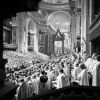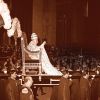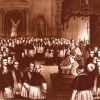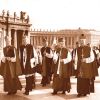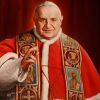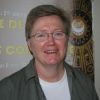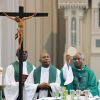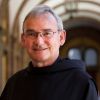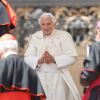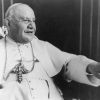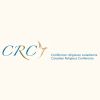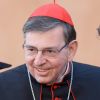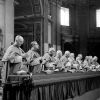The movers and shakers behind the Second Vatican Council
The Second Vatican Council was the biggest stage in the history of the Church. There were more bishops present than at any the 20 previous councils stretching from the First Council of Nicaea in 325 to the First Vatican Council of 1870. And the bishops present came from more countries, more cultures, more languages than the Church had ever experienced.
A Church reborn: The 50th Anniversary of Vatican II
On Jan. 25, 1959, a new pope shocked the world. Pope John XXIII, speaking to a small group of Roman cardinals following a liturgy to conclude the Week of Prayer for Christian Unity, announced that he had decided to convene an ecumenical council.
Pope John, elected less than three months earlier, had previously told only one person of his plan and had consulted with no one else. He had little ideaof why he wanted a council. He did however refer to “the strengthening of religious unity and the kindling of a more intense Christian fervour.”
The Church, he said, was on the threshold of a new era in history when it would be necessary “to define clearly and distinguish between what is sacredprinciple and eternal Gospel and what belongs rather to the changing times.”
With those comments, Pope John struck a few notes that would eventually help to characterize the much-maligned “spirit of Vatican II,” but not until after concerted resistance from the Vatican’s own Curia had been overcome.
Essentially, the Pope’s decision to call the council was an inspiration or an intuition that such a great gathering was needed. When the council finally opened on Oct. 11, 1962, he said the idea for the council had come “like a flash of heavenly light” . . . “a sudden emergence in our heart and on our lips of the simple words ‘ecumenical council.’ ”
Few, if any, ranking churchmen in early 1959 believed that a council was necessary. In the past, councils had been called to respond to crises in the Church, especially over doctrine. But now there was no doctrinal crisis nor was there a pastoral crisis. The Church was apparently in wonderful shape, certain of its teaching and, throughout the Western world, its worship halls were full.
Moreover, after the First Vatican Council in 1870 had declared the doctrine of the infallibility of the Pope, many believed that there would never again be a need for a worldwide council. Gotta problem? The Pope will solve it with a clear, unequivocal declaration.
But Pope John did call a council. And what a council it was! Fifty years later, its reverberations are still being felt throughout the Church. Indeed, the debate over what the council said and meant is ongoing, even increasing in fervour. The process of implementing the council is still incomplete.
Today, the 16 documents of the Second Vatican Council form a foundation for the life of the Church. But if in 1965 those documents seemed almost revolutionary, today they seem less so.
Angelo Giuseppi Roncalli became a pope like no other in the 20th century. He rose to become Pope John XXIII basically under the radar and was formed by a unique set of experiences that helped him understand that the action of the Holy Spirit is not confined to the Catholic Church.
He was not a radical or even an innovator. Judged by today’s standards, his public comments and private correspondence can only be described as quite conservative. While his papacy had a markedly different style than that of Pope Pius XII, his reserved predecessor, Pope John seems to have taken only one off-the-wall action in his life — to convoke Vatican II.
In October 1958, Pope Pius XII died after years of illness. Roncalli was quickly seen as one of the leading candidates to be his successor. Why? First, at age 76, he would be a transitional pope after Pius’ long 19-year pontificate. Second, he was not part of the Vatican power structure that had grown too strong in Pius’ declining years. Third, he was seen as a bridge-builder, someone who would be accessible to the cardinals and a pastor to the people.
Further, although he was 76, Roncalli was actually one of the younger cardinals. Pius had held only two consistories to appoint new cardinals during his long pontificate. With only 51 cardinals entering the conclave and many of them quite elderly, the pool of papal candidates was small.
Still, it took 11 ballots before he was finally elected. Why the hesitation? Some, it appears, felt Roncalli lacked the intellectual heft to lead the Church, even for a short period. Nevertheless, he was elected and chose the name John. Less than three months later, this “transitional pope,” without consulting anyone other than the Holy Spirit, started the wheels in motion for the Second Vatican Council.
Recently, a group of scholars published a book, Vatican II: Renewal Within Tradition. The book examines the 16 documents in some detail, carefully pointing out that the council did not erase what came before it. The teachings of Vatican II are totally in continuity with what the Church had taught previously. There is evolution and development of doctrine, but no radical break with the past.
This may be true, but those old enough to remember the Church before Vatican II, and who recall the earthquake that it represented in the life of the Church, cannot be satisfied with such a placid account.
Franciscan Father Don MacDonald, who teaches a course on Vatican II at Newman Theological College in Edmonton, believes Vatican II has been misunderstood. Some believe the purpose of the council was to make being a Catholic easier and to help Catholicism adapt to the modern world. That’s wrong on both accounts.
The Church has never tried to adapt itself to the world, MacDonald said, and the council made the faith more demanding, “in the best sense of the word.” The Church before Vatican II was not the good ol’ days, he said. A lot needed to change.
In the seminary, MacDonald recalls being taught that how a priest celebrates Mass was more important than what was being celebrated. The emphasis placed on how the priest held his hands during Mass “was almost like a phys-ed exercise.”
Still, there was a lot of “heroic Catholicism” and a strong emphasis on social action in the Church prior to the council, he said. “You have to have respect for that pre-Vatican II faith.”
There is more to Vatican II than what is found by studying its documents. If there was doctrinal continuity in the council’s teachings, there was also an enormous upheaval in the life of the Church. Some of that upheaval may well be due to misinterpretations and over-enthusiasms. Part of it is no doubt the result of a greater embracing of Western culture which, in the 1960s, underwent massive convulsions.
But above and beyond all that, a sea change took place in the Church that was necessary and productive.
The liturgy underwent a process of revitalization that is still continuing. Greater contact with non-Catholic Christians and people of other faiths was encouraged. A static, deadening approach to theology was jettisoned in favour of one that allowed room for inquiry and evolution.
The Church endorsed religious liberty and rejected the notion that error has no rights. The full equality of the People of God in Baptism was recognized and holiness was seen as God’s call to everyone, not just a spiritual elite. There was, in short, greater openness and less fear of “enemies.”
For many, that openness was disorienting. When the central religious rituals of one’s life are altered, it is likely to deeply unsettle one’s relationship with the Transcendent. That fact and the effects of other changes were not sufficiently appreciated in the mid- 1960s. These are likely not the only causes of a mass exodus of priests and religious from their callings and laity from regular Church attendance. But an honest evaluation of the changes should see them as contributing factors.
Still, a reform of the liturgy was necessary and perhaps overdue. As well, it must be said that one can be faithful to the letter of the Church’s teachings and still acknowledge a legitimate “spirit of Vatican II” that is in harmony with those teachings. It is impossible to tell the full story of Vatican II without acknowledging its history and without trying to come to grips with that legitimate spirit.
Communications and transportation networks were far less developed 50 years ago. As well, the Church’s theology of collegiality among bishops was practically non-existent and there were few joint episcopal efforts. When the bishops arived at Vatican II in 1962, many were meeting prelates from around the world for the first time.
Canada’s bishops and Catholic universities were among those who responded to the Vatican’s call in 1959 for input about topics to be considered at the Second Vatican Council. Canada was a far different country then and the same could be said for the Canadian Church. If parishes and dioceses today seem to be somewhat isolated cocoons, it’s nothing compared with the situation prior to Vatican II.
Given all that, it is perhaps not surprising that suggestions from Canada’s bishops lacked vision. In the mid-1990s, Michael Fahey of the University of St. Michael’s College in Toronto examined the input of the Canadian bishops prior to the council. For the most part, it reflected “notably weak” theology and the “generally poor state of collegiality in Canada,” Fahey wrote in L’Eglise canadienne et Vatican II (edited by Gilles Routhier). But what is remarkable, he noted, is the extent to which their vision was transformed by the time Vatican II ended in 1965.
What did the Pope expect out of Vatican II? Raised in the tiny village of Sotto il Monte by peasant farmers who kept cows in their house, Pope John had the audacity to convoke an ecumenical council of the entire Roman Catholic Church. Moreover, he didn’t even have a plan for this whimsical council. But he said it would provide for “the enlightenment, edification and joy of the entire Christian people” and that the faithful of other Christian churches would be invited too.
The Pope said the idea to call the council came to him “like a flash of heavenly light.” Other Church leaders felt quite in the dark.
Pope John was known for his sense of humour and his positive outlook on life. Perhaps it was these factors that led him to say, two years after his Jan. 25, 1959 announcement that the Church would hold a worldwide council, that the announcement was greeted by the cardinals present with “a devout and impressive silence.”
No applause greeted the papal announcement in the Basilica of St. Paul. Church historian Giuseppe Alberigo says the reaction of the 17 cardinals present was “characterized by bewilderment and worry.”
No one in the know could see any reason for a council. For the Rome-based cardinals, who had run their offices at the Vatican with little oversight from the ailing Pope Pius XII for several years, a general council could only mean trouble. The Vatican would be flooded with bishops from around the world, bishops unfamiliar with Roman ways, the vast majority of whom the cardinals themselves did not know.
Even Cardinal Giacomo Lecaro of Bologna, who would later become one of the progressive leaders at Vatican II, groused, “How dare he summon a council after 100 years and only three months after his election? Pope John has been rash and impulsive. His inexperience and lack of culture brought him to this pass, to this paradox.”
Cardinal Giovanni Battista Montini, later Pope Paul VI, was initially cool to the call for a council. But perhaps inspired by the excitement in his Milan archdiocese, he wrote a pastoral letter stating, “A flame of enthusiasm swept over the whole Church. He understood immediately, perhaps by inspiration, that by calling a council he would release unparalleled vital forces in the Church.”
If many cardinals were dubious about the council, the rest of the world was not. Almost spontaneously, people around the world — Catholic and non-Catholic — saw the council as a great sign of hope and renewal in the Church. The expectation created overnight was tremendous.
(Western Catholic Reporter)
Councils date back to early days
The model for all ecumenical councils is the Council of Jerusalem, recalled in the Acts of the Apostles, chapter 15. However, it is not generally listed as one of the 20 ecumenical councils of Church history. Ecumenical (from the Greek word oikoumene) means worldwide, and the first one was called by the Emperor of the known world, Constantine I.
1. First Council of Nicea in 325 defined the heresy of Arianism.
2. First Council of Constantinople in 381 again repudiated Arianism.
3. Council of Ephesus in 431 declared Mary as "God carrier" or Theotokos.
4. Council of Chalcedon in 451 made more explicit that Jesus' divine and human natures were united in a single being.
5. Second Council of Constantinople in 553 condemned Origen of Alexandria, the first great Scripture scholar of Christianity, for some odd ideas he had about the transmigration of souls.
6. Third Council of Constantinople in 680-681 dealt with more threats to unity of Christ, specifically a theory that Jesus had two wills — one divine and one human — but one nature. Monothelitism was condemned as heresy.
7. Second Council of Nicea in 787 tried to stop people from going around smashing icons. Veneration of icons was defined as good and iconoclasm was condemned.
8. Fourth Council of Constantinople in 869-870 restored St. Ignatius to his throne as Patriarch of Constantinople.
9. First Lateran Council in 1123 excommunicated the Holy Roman Emporer Henry V and declared it heresy for kings, princes and even the Holy Roman Emporer to appoint bishops. This was known as the investure controversy and it went on for centuries. The council also tried to impose celibacy on secular priests.
10. Second Lateran Council in 1139 was another attempt to get kings out of the business of the Church, and also tried to reform the clergy, including another condemnation of marriage among priests.
11. Third Lateran Council in 1179 condemned the sale of sacraments and positions in the hierarchy (simony) and declared only cardinals could elect the pope.
12. Fourth Lateran Council in 1215 defined transubstantiation, a term that remained controversial at the Second Vatican Council.
13. First Council of Lyon in 1245 excommunicated and deposed Holy Roman Emperor Frederick II who had put Rome under siege. Pope Innocent IV also used the Council to strike an alliance with King Louis IX of France and launch the Seventh Crusade under the French king's command.
14. Second Council of Lyon in 1274 under Blessed Pope Gregory X tried to repair the Great Schism of 1054. However, Greek Orthodox bishops were condemned for attending the Council when they returned home.
15. Council of Vienna in 1311 to 1312 marked the end of the crusades. The Knights Templar lost their Church support and Franciscan Ramon Llull (Raymond Lully) convinced the Council fathers the only way to retake the Holy Land was to learn the languages — specifically Hebrew, Arabic and Greek.
16. Council of Constance in 1414 to 1418 had to solve the problem of three popes: Anti-pope John XXIII, Avignon Pope Benedict XIII and Pope Gregory XII had all been elected by some bishops in a situation known as the Western Schism of 1378 to 1417. The Council of Constance resolved the schism by declaring an ecumenical council is a higher authority even than the pope who convokes it and then installing Pope Martin V.
17. Council of Florence opened in 1431 in Basel with no bishops, moved to Ferrara, Florence and finally Lousanne. There were wars in Bohemia, a rising threat in the Ottoman Empire and plague. The council tried to assert the idea of conciliarity, that councils should be part of the normal governance of the Church, and it achieved a short-lived reconciliation with some Greek Orthodox bishops and the Armenian Church.
18. The Fifth Lateran Council, the last before the Reformation, from 1512 to 1517 amounted to a battle royal between the forces of conciliarism and Pope Julius II's convictions about papal authority. Master of the Dominican order Thomas Cajetan argued for absolute papal authority against University of Paris theologian Jacques Almain. The Council passed a decree backing Cajetan's position.
19. Council of Trent from 1559 to 1565 tried to answer the challenge of Martin Luther, but came along too late to reunite a divided Western Church. The council's doctrine of salvation, definitions of the sacraments and reforms to the liturgy defined Catholicism for 350 years. It initiated the Catechism of 1568, a new Roman Missal which defined the Tridentine Mass, issued a new edition of the Vulgate — the Bible in Latin — and pronounced a long series of anathemas. It also envisioned the seminary system in the hope of a better educated clergy and encouraged the Mass in local languages, a reform that had to wait for the Second Vatican Council.
20. First Vatican Council of 1869 to 1870 defined papal infallibility. Papal infalibility was then used in 1950 by Pope Pius XII to declare the Assumption of the Blessed Virgin Mary into Heaven a universally accepted dogma of the Church.
21. Second Vatican Council of 1962 to 1965 was convoked after the Second World War and during the Cold War by Blessed Pope John XXIII.
Canadian influence unmistakable at Vatican II
Rome on Oct. 11, 1962, but the drama started in Canada Aug. 17 that year.
For a year and a half Cardinal Paul-Emile Leger, archbishop of Montreal, had been one of a handful of cardinals on the central preparatory commission of the council. It had met seven times between June 1961 and the feast of Pentecost, 1962. And then Leger received his book of draft documents assembled by curial officials in Rome.
Leger was not pleased with what he saw. On Aug. 17 he launched a “supplique” — a letter of petition — addressed directly to Pope John XXIII. Leger told the Pope in no uncertain terms the documents prepared in Rome were unworkable, impractical and simply wrong. They were wrong in their tone, their language and their limited vision. The council must present the traditional faith of the Church pastorally. For Leger, it was imperative the council find new modes of expression. Leger’s “supplique” eventually gathered the signatures of a number of heavyweights in the College of Cardinals.
On Sept. 17 Leger got a message back through Cardinal Amleto Cicognani, the Vatican’s Secretary of State, saying that the Pope had favourably received the supplique. How favourably became clear when the Pope opened the council on Oct. 11. Pope John XXIII immediately emphasized conciliarity by recalling that council had been throughout history the highest teaching authority in the Church. Then the Pope took a swipe at cautious, gloomy curial officials who would rather not address the modern world.
“We feel that we must disagree with these prophets of doom, who are always forecasting worse disasters, as though the end of the world were at hand,” said the Pope.
But Canadian influence on the council did not stop there.
“One of the key elements of the council is conciliarity within the Church. And one of the major voices promoting conciliarity within the council is Maxim Hermaniuk. It’s clear as night and day,” said Fr. Myroslav Tataryn, St. Jerome’s College professor of Church history.
Hermaniuk was the Ukrainian Metropolitan Archeparch of Winnipeg, and he chaired the 15-member Ukrainian Catholic delegation. He called for a permanent synod of bishops to collaborate regularly with the pope. He favoured presenting the liturgy in local languages. He fought for respect for the 21 non-Roman rites of the Catholic Church and championed the cause of ecumenism by pointing out the theological irrelevance of the mutual ex-communications between the patriarch of Rome and the patriarch of Constantinople in 1054.
As an Eastern Catholic Hermaniuk knew the spiritual and practical value of synods.
“He recognized that (synods) are not just something the Eastern Churches hold dear. It is part of the apostolic heritage,” said Tataryn. “It is the way in which the early Church operated. It doesn’t take anything away from Peter. It doesn’t take anything away from the Roman papacy. It is simply a recognition that the fullness of the Church’s life is expressed in that balance.”
He never got the permanent synod of bishops, but Hermaniuk started a conversation that goes on to this day.
“So Hermaniuk put out the proposal. It gets formulated in different ways. We still haven’t worked out how synodality works in the Catholic Church today,” said Tataryn.
German-born Canadian theologian Gregory Baum played a central role in drafting the first text on the relationship between Christians and Jews — a document that would eventually become Nostra Aetate.
Baum’s involvement began at a meeting with Cardinal Augustin Bea to discuss ecumenical relationships with non-Catholic Christians.
“At the end of the meeting Cardinal Bea said, ‘I just saw the Pope, and he said to us that he wants the secretariat to prepare a statement to rethink the Church’s relationship to the Jews,’ ” Baum recalled in an interview with The Catholic Register.
Bea was looking for experts who could contribute and Baum had published a book on the subject. From that point forward Baum worked closely with Bea.
Baum is incredulous when people suppose that somehow wily, elite, academic theologians were leading the bishops along at the council.
“These things came from the very top. The theologians were asked to help in this, to write texts and so on, but the initiative came from the top,” he said.
“It would be quite wrong to think this was run by theologians.”
Canadian bishops who had roles in helping to prepare for the council included Quebec Archbishop Maurice Roy (who was made a cardinal at the end of the council), Toronto Auxiliary Bishop Philip Pocock (who became Toronto’s archbishop in 1971), Winnipeg Archbishop George Flahiff (who was made a cardinal in 1969) and Sault Ste. Marie Bishop Alexander Carter.
Pocock was a consultor to the Commission for the Discipline of the Clergy and the Christian People. Once he held the reins in Toronto, he put his Vatican II experience into action by ordaining deacons. Pocock’s model of the revived diaconate survives to this day and is imitated all over North America.
Carter dedicated the rest of his life to lifting up the laity, creating the Diocesan Order of Service and the Diocesan Order of Women. He empowered women and native elders to preside at communion services when no priest is available, minister to the sick, witness weddings, baptize and lead wake services.
Carter was “entirely transformed by it,” said Michael Attridge, a University of St. Michael’s College theologian and historian of the council.
“He saw himself as someone who needed to implement the council in the diocese of Sault Ste. Marie in the years following,” Attridge said.
As a young priest studying canon law at The Angelicum (the University of St. Thomas Aquinas in Rome) during the council, retired Hamilton Auxiliary Bishop Matthew Ustrzycki witnessed a whole new side of the Church. The pre-Vatican seminaries of North America were not hotbeds of controversy and debate, but in Rome people were arguing theology in the street.
All the passion and idealism of the council took place against a backdrop of imminent doom. The Soviet Union had tried to install nuclear missiles just a few miles off the American coast in Cuba. Memories of the Holocaust and Europe at war were fresh. Communism and capitalism had the world divided in half.
But the Second Vatican Council wasn’t just about bishops and theologians. It addressed itself to the whole world, and Canadians took that very seriously.
“It helped us to understand the call to justice,” said Saint Paul University theologian Cathy Clifford. “That solidarity with the poor and the call to justice were an integral part of our faith commitment. I don’t hear that as much today.”
The times called forth optimism from Canadians, recalls Janet Somerville, retired general secretary of the Canadian Council of Churches.
“We were tremendously optimistic about our heritage and our future at that time,” she said. “That did condition the way we read the texts of the council.”
Canada’s middle class was growing and Catholics were joining it in record numbers. And that meant a sea change in Catholic attitudes, said Somerville.
The tragic world view of suffering immigrant Catholics was on its way out as the council convened.
“Catholics were sociologically emerging from that during the ’60s,” said Somerville. “They kind of identified the council’s agenda with their own agenda of being much more satisfied with the world — because the world was treating them better.”
Much of the Canadian history of Vatican II is still being written in how the council is interpreted. Winnipeg Archbishop James Weisgerber tells anybody who will listen that it takes 100 years to understand and implement an ecumenical council. As a historian, Attridge is trying to understand how three generations of bishops — the ones who participated in the council, the ones ordained shortly after and the bishops in place now — have interpreted Vatican II.
“It would be interesting to map the change in the Canadian bishops as we move further away from the council,” he said.
“In general, councils don’t happen very often,” said Clifford. “Even to understand what a council is and how a council deliberates is something.
A better Church
Fifty years ago this week the largest gathering of bishops ever assembled heeded a call from Pope John XXIII to attend the opening of the Second Vatican Council.
It was a remarkable event. Each time the council was in session between 1962 and 1965 more than 2,000 bishops were present. They came from all corners of the world and, in sheer numbers, they were triple the total number of bishops (almost entirely European) who attended the First Vatican Council a century earlier. The Catholic world had never seen anything like it and, in many regards, Catholicism has not been the same since.
The Church today is better because of Vatican II. It’s not perfect, far from it. The task of interpreting and implementing the council’s 16 documents is ongoing. But Vatican II wasn’t a quest for perfection. It was about spiritual renewal and Christian unity in a post-war world on the cusp of extraordinary social, economic and technological revolution. Space flight was turning our thoughts to the heavens and Pope John sought to ensure God’s place on that journey.
“It is not that the Gospel has changed,” the Pope said at the time. “It is that we have begun to understand it better . . . the moment has come to discern the signs of the times, to seize the opportunity and to look far ahead.”
Vatican II lasted three years (with a nine-month hiatus after Pope John’s death in 1963) and the Church did indeed emerge spiritually invigorated. But, regrettably, not totally united. Considerable disagreement remains between those who say the council went too far and those who say it didn’t go far enough, between those itching to hit the rewind button and those longing to push fast forward. That disagreement won’t blacken the golden anniversary celebration but, unfortunately, it could soften the glow.
This issue of The Register devotes eight pages of special coverage to Vatican II but barely skims the surface of those historic days. What’s important to note, however, is that Vatican II was about evolution of Church practices, not revolution of Church doctrine. The council produced no radical doctrinal break with the past but, in keeping with Pope John’s intent, it emboldened the bishops to be future-looking.
The past half century has witnessed a whirlwind of social, scientific and economic innovation that, today, regularly pits society’s shifting values against the Church’s fundamental teachings. It might be a stretch to suggest Pope John saw all this coming. But he sensed something was up. The Second Vatican Council was the fruit of that foresight.
But, in the words of Winnipeg Archbishop James Weisgerber, it could take 100 years to fully understand all the implications of Vatican II. It’s a journey and we may only be half way there.
We rejoice the triumph of the Lord Jesus Christ
“Gaudet Mater Ecclesia! Mother Church rejoices!”
On Oct. 11, 1962, Blessed John XXIII opened the Second Vatican Council with that famous allocution. This year, his successor will return to the Vatican basilica to commemorate the 50th anniversary of the council. It is not only about looking backward though, for Pope Benedict XVI will simultaneously open the Year for Faith, in which the whole Church will be asked to discover anew her faith in Jesus Christ.
Ten years ago on Oct. 11, I was at St. Peter’s and had the privilege with some of my classmates to offer the Holy Mass at the altar over the tomb of Blessed John XXIII himself. The principal celebrant that day was Archbishop Timothy Dolan, then the archbishop of Milwaukee, who had been the rector of the Pontifical North American College when I and my classmates were students there. The then rector, Msgr. Kevin McCoy joined us, as did friends of Archbishop Dolan. More than that, the day was especially memorable as my own parents were present.
At the space of then 40 years — and now 50 — Oct. 11, 1962, manifestly marked out a new path for the Church in the history of our time. That path has not been without twists and turns, successes and disappointments, as mark the Church’s pilgrimage toward the Lord of history. Most fundamentally, the council remains what it was from the beginning, a summons to proclaim with new missionary fervour the Gospel in our time.
“Gaudet Mater Ecclesia captured the spirit of the Council and the spirit of the pope who convoked it,” the preacher, a newly ordained priest, said that morning 10 years ago at the tomb of that very same pope. “Those resonant words are an answer to the question: What does the Church do?
“The Church rejoices. It is her mission. It is what she exists in the world for. To rejoice. She rejoices because she knows, as St. Paul teaches us, ‘that through Christ Jesus the blessing bestowed on Abraham might descend on the gentiles in Christ Jesus.’ She rejoices because the promise made to Abraham is fulfilled in Jesus Christ, her Bridegroom, her Saviour, her Redeemer, her Lord. The Church rejoices because of the ‘wondrous deeds’ of the Lord. ‘Great are the works of the Lord, exquisite in all their delights,’ sings the psalmist.
“Pope John XXIII chose this date to open the council because it was the feast of the divine maternity of Mary,” the homilist noted. “When that feast was moved to Jan. 1, Oct. 11 became free and was given to Blessed John XXIII, in memory of his most memorable words, spoken here in this basilica, only a few feet from where we are this morning: Gaudet Mater Ecclesia! His feast and this anniversary are truly an exquisite delight from the Lord.
“In that landmark address of Oct. 11, Pope John gave us several memorable phrases, warning us against the ‘prophets of gloom’ and inviting the Church to show the ‘medicine of mercy.’ Yet there is one passage that speaks to the heart of the council’s message and heart of Angelo Roncalli’s life, words that echo today’s Gospel: The great problem confronting the world after almost 2,000 years remains unchanged. Christ is ever resplendent as the centre of history and of life. Men are either with Him and His Church, and then they enjoy light, goodness, order and peace. Or else they are without Him, or against Him, and deliberately opposed to His Church, and then they give rise to confusion, to bitterness in human relations and to the constant danger of fratricidal wars.”
The joy which Blessed John XXIII proclaimed 50 years ago was not about pasting a smiley face on the Church so as to make her more popular. The Church rejoices because Jesus Christ has triumphed, and that His love is stronger than all the principalities and powers of the world arrayed against Him.
Today, more than 50 years ago, there are still many — likely a majority in Canada now — who are without Jesus, against Jesus or even deliberately opposed to His Church. The damage they wreak is great. The consequences of their decisions have grave consequences in this world and the next.
There are so many apart from Christ who bring to our common life so much sadness and wickedness, and even a metaphysical boredom that can be worse. Precisely for this reason does the Church need to bring the world joy — 50 years after the council, 50 years from now, and forever after that. Gaudet Mater Ecclesia!
Dull roar of toothless lions
With the 50th anniversary of the opening of the Second Vatican Council less than two weeks away (Oct. 11), the old lions of the council are getting ready to roar once again.
As a young priest, Pope Benedict XVI was at the council as a theological advisor, or peritus. As Pope he has made the proper interpretation of the council a key part of his teaching, and declared a Year of Faith to begin on Oct. 11, asking the Church to rediscover the riches of the council in light of the demands of the new evangelization.
There are other lions too. Some of them will be highlighted at a Vatican II conference this weekend at Saint Paul’s University in Ottawa. The conference has been criticized as being something of an oldtimers’ game for theological dissenters. The presence of Gregory Baum, the former priest who at one time had a rewarding career proposing that the Church was wrong on just about every issue in which her teaching clashed with secular culture, set off alarm bells for those easily alarmed. He too was a peritus at the council. But at nearly 90 years old, Baum is a lion no longer. More than a theological force, he is now of principal interest as a relic of a time when the future of the Church was going to be an abrupt break with her past. Baum and his companions thought that Vatican II meant a new Church, adapted to the times and taking its lead from the ambient culture. The idea that the ambient culture of the late 1960s and 1970s was a special repository of wisdom was just one fatal flaw in that scheme.
The Catholic journalist Robert Blair Kaiser is another of the old lions, rather grumpy now that the new Church never quite took hold in the Catholic world as it did in the world of mainline Protestantism. He wrote recently about the council, quoting the Jesuit historian John O’Malley, about how exciting it all was back when he was a young journalist covering the new Church about to be born. Vatican II, he wrote, took the Church “from commands to invitations, from laws to ideals, from definition to mystery, from threats to persuasion, from coercion to conscience, from monologue to dialogue, from ruling to service, from withdrawn to integrated, from vertical to horizontal, from exclusion to inclusion, from hostility to friendship, from rivalry to partnership, from suspicion to trust, from static to ongoing, from passive acceptance to active engagement, from fault finding to appreciation, from prescriptive to principled, from behaviour modification to inner appropriation.”
It’s amazing the Church staggered through nineteen-and-a-half centuries in such sorry shape, until everything was made new in the 1960s, from tradition to buzzwords all around. Going from “behaviour modification” to “inner appropriation” likely means little, but the general direction is clear. One does not change one’s behaviour in response to the Gospel standard, but rather appropriates what one already is and how one already lives.
Blessed John Paul II had a rather different idea of the council’s task, as he wrote in preparation for the Great Jubilee:
“The Second Vatican Council was a providential event, whereby the Church began the more immediate preparation for the Jubilee of the Second Millennium. It was a Council similar to the earlier ones, yet very different; it was a Council focused on the mystery of Christ and His Church and at the same time open to the world. This openness was an evangelical response to recent changes in the world, including the profoundly disturbing experiences of the 20th century, a century scarred by the First and Second World Wars, by the experience of the concentration camps and by horrendous massacres. All these events demonstrate most vividly that the world needs purification; it needs to be converted” (Tertio Millennio Adveniente, # 18).
The conference at Saint Paul’s may be rather light on the need of the Church to purify and convert the world. That will be the rather intense focus of the synod on the new evangelization to be held in Rome next month. The more relevant speakers this weekend in Ottawa will have the same focus, led by Cardinal Peter Turkson, the Ghanaian prelate now heading up the Holy See’s office for justice and peace. But the retired lions will also have their say, like old men gathering to tell the stories about how wise they were once, and how their wisdom lives on still. It’s polite to listen, as one throws a toothless lion a bone.
OTTAWA - An Ottawa conference Sept. 27-29 marking the 50th anniversary of the Second Vatican Council will examine how to “hand on the
Gospel today” in light of Vatican II’s teachings, said Saint Paul University theology professor Catherine Clifford.
“One of goals is to promote the pastoral renewal of the Church,” said Clifford, an organizer of the Vatican II: For the Next Generation Conference. Co-sponsored by Saint Paul’s Vatican II and 21st Century Catholicism Research Centre and Novalis, the conference will begin a week before bishops from around the world gather in Rome for the Synod on the New Evangelization.
“The world we live in today is very different from the world 50 years ago,” Clifford said. “Many of the questions are not the same questions the bishops were reflecting on in 1962-65 in the Council.”
When Vatican II opened 50 years ago, it took place against the backdrop of the Cold War, less than 20 years after the end of the Second World War, said Clifford. Since then there has been a marked shift to the global integration of societies and culture, she said.
“It’s an era of an unprecedented migration of peoples,” she said. “The population of the world has more than doubled; the population of the Catholic Church has more than doubled.
“The majority of Catholics live not in Europe and North America but in the Southern hemisphere. We are a very different Church than we were 50 years ago.”
Though poverty and social injustice remain challenges, “in some ways those issues are far more complex than they were 50 years ago,” she said.
Another sign is the growing recognition of the dignity of the human person that is probably even stronger than it was 50 years ago, when the civil rights movement in the United States was gaining momentum, she said.
The conference will feature a keynote address by Cardinal Peter Turkson, president of the Pontifical Council for Justice and Peace and one of the names that frequently appears in speculation about future popes. The cardinal will speak on “Vatican II: A Council of Justice and Peace.” He will also receive an honorary doctorate at a special convocation in the university chapel on Sept. 28.
Other conference attendees include dogmatic theology professor Christoph Theobold, S.J., from the Centre Sèvres in Paris, France, and Boston College systematic theology professor Richard Gaillardetz. The conference will feature a panel of bishops and advisors who participated in the Council, including Bishop Remi De Roo and Bishop Gerard J. Deschamps, and advisors Gregory Baum and Leo Laberge, omi.
See www.ustpaul.ca or e-mail vaticancentre@ustpaul.ca.
NEW YORK - In the 50 years since the Second Vatican Council encouraged Catholics to read, reflect and act on Scripture, there has been a "surging vitality in the life of the church," according to Cardinal Peter Turkson, president of the Pontifical Council for Justice and Peace.
"There is nothing that the church does that is not rooted in Scripture," he told participants at the New York Catholic Bible Summit June 16.
VATICAN CITY - Half a century after the start of the Second Vatican Council, the reform of the liturgy initiated there has not lost its power to stoke controversy.
On June 13, after years of on-again-off-again talks with the traditionalist Society of St. Pius X, which effectively broke from Rome almost 25 years ago to protest the teachings of Vatican II and subsequent changes to the Mass, the Vatican announced that the traditionalists had been formally offered terms of reconciliation.
ROME - A misunderstanding of the Second Vatican Council has led some Catholics to think that eucharistic adoration and Corpus Christi processions are pietistic practices that pale in importance to the celebration of Mass, Pope Benedict XVI said.
"A unilateral interpretation of the Second Vatican Council has penalized this dimension" of Catholic faith, which is to recognize Jesus truly present in the Eucharist and worthy of adoration, the Pope said June 7 during a Mass marking the feast of the Body and Blood of Christ.
WASHINGTON - With observances of the 50th anniversary of the Second Vatican Council being conducted around the world, one church historian cautioned that the council's documents should be studied comprehensively, lest they be misunderstood or their reforms dismantled piece-by-piece.
Jesuit Father John W. O'Malley, a professor in the theology department at Georgetown University who is renowned for his work in church history, said the documents should be considered as one body of work, not as unrelated parts.
He was asked to speak to the Catholic Common Ground Initiative about the significance of just one of the council's 16 documents, "Gaudium et Spes," the Pastoral Constitution on the Church in the Modern World.
MONTREAL - The new attitude initiated by the Second Vatican Council and the changes in society in the last 50 years has deeply affected the life of the Church and the life of religious communities, 290 leaders of religious communities in Canada were told.
The leaders gathered here May 24-28 for the bi-annual assembly of the Canadian Religious Conference (CRC) at which time they also chose a new executive.
ROME - The Catholic Church's relationship to Judaism as taught by the Second Vatican Council and the interpretations and developments of that teaching by subsequent popes, "are binding on a Catholic," said the Vatican official responsible for relations with the Jews.
Swiss Cardinal Kurt Koch, president of the Pontifical Commission for Religious Relations with the Jews and a member of the Congregation for the Doctrine of the Faith, spoke to reporters May 16 after delivering a speech on Catholic-Jewish relations in light of Vatican II's declaration "Nostra Aetate" on the church's relations with non-Christian religions.
ROME - The Second Vatican Council's teaching, particularly on Judaism and other religions, is rooted in traditional Christian theology and the Bible, and the Catholic Church should not offer concessions to those who do not accept its teaching, said an Israeli-born Franciscan who serves as a judge on a top Vatican court.
Msgr. David Jaeger, a judge at the Roman Rota, defined as worrying a tendency, "here and there in Catholicism, to look leniently upon stray groups that are marginal but well-publicized who denounce the doctrine of the council, including the declaration 'Nostra Aetate'" on the relationship of the church to non-Christian religions.


